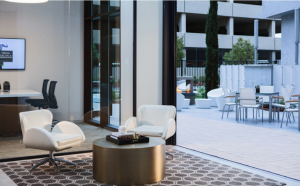
Boutique hotels began the rise to fame in the 1990’s when guests began to want more from their interior design for hotel rooms, and something that was more than four walls and a bed. This idea of wanting more has only continued with the expansion of Millennial travelers and what they want from their hotel experience. Something that boutique hotels have always done well, and what draws many people to them is, minimalistic design elements, their connection with the location, and supporting art.
Minimal Design:
Minimalistic design gives power to the image of there being less of. Minimal design plays with hues and negative space. Delano in Miami which many consider to have brought rise to the luxury boutique hotels, has a very simple design palette, tall ceilings, greenery around the pool to give it a feeling that you are tucked away in a forest, quirky furniture, and art instillations. With minimalistic design hotels can bring the focus on certain rooms and areas by adding focal points created by playing with color or metals. Minimal design can often lead to a lack of color, hotels have begun to off put that by adding elements of greenery, and while greenery used to only be used for landscaping, now hotels have begun to add in greenery through indoor plants.
All About Location:
When guests travel, they are traveling for the location, and hotels that can help bring the location to life in their hotel, help to create a better guest experience. With many boutique hotels being located in secondary cities, or in smaller towns, they have created the trend of connecting with the location. This can be seen through boutique hotel interior design elements that hold the history of the building in the center of its design, works with local furniture shops to create the pieces, and restaurants that cook seasonal and locally grown food. The benefit of having a restaurant that changes its menu seasonally is that to guests the frequent the location often they will feel as though they are eating at a new restaurant each time. Seasonal menu changes can also lead to seasonal décor changes to better complement the palate. With a focus on location, hotels can sponsor and hold local events that their guests can attend while staying in the hotel, and further giving them an experience specific to their hotel. Many events are in collaboration with clothing labels, health events, and lectures.
Local Art:
While boutique hotels have taken to local artist and even picture of their own hotel grounds to decorate their hotel. Other hotels are drawing inspiration from that and putting more of an emphasis on art. Whether that art is from local artist, or just big instillations and pieces to decorate the walls. Hotels are realizing that beautifully created art can not only help tell their story, but add inspiration into the lives of their guests as well.
While the rise of boutique hotels began in the 1990s they are still growing and the inspiration and impact on the hospitality and design business is one that has shaken the industry to its core. While hotels have begun to draw inspiration from boutique hotels, many big box hotel chains have begun to even create boutique hotels of their own to appeal to guests wanting to connect more with their travels rather than just booking a room to just sleep in.